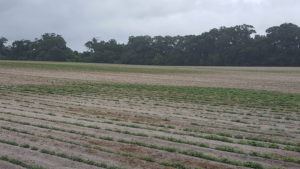
These peanuts were probably planted into too dry of conditions. The plant stands appear reflective of landscape position.
Peanuts were planted into tough conditions this Spring in north Florida. Many fields now have skippy stands, and we have questions about replanting. However, until only recently we were not offered the rainfall and improved planting conditions, and what has become weeks of rainfall has kept us out of the fields. Some farmers have questioned whether seed quality, soil moisture, or both were factors this year. It has been difficult to rule out one or the other. We had farms that the operators maintain they planted into good moisture; several I observed planting conditions myself, and still had poor stands. Other fields were probably planted into acceptable moisture, but the hot and dry conditions probably zapped that available moisture too fast. Other fields we simply pushed the envelope planting into dry conditions. However, in some cases we see irrigated fields with unacceptable stand counts and are left wondering why. Widespread rain has started, and in my experience this rainfall can cover up a lot of problems. For example, cooler temperatures and sufficient rainfall turned a lot of poor fields into really good peanuts by harvest in 2012.
Farmers are left looking for advice if it is worthwhile to replant, especially at this late date. Dr. Scott Tubbs, the Peanut Research Agronomist at University of Georgia recently shared a summary of his research collected over several years:
“Replanting did not improve yield over leaving an initially poor plant stand alone as often as I would have anticipated. Combined over multiple trials and multiple years, the only consistent result for improving yield at a point that it would be economically viable to justify the cost of replanting was when plant stands were as low as 1.0 plant per foot of row. If plant stands are at least 2.5 plants per foot of row the chances of gaining a return on the investment of replanting a field is very low. ”
“There was consistency among multiple trials that a burndown herbicide application followed by replanting at a full seeding rate of peanut was not a successful practice and was much more costly than a supplemental replant scenario, or even than leaving the original stand alone. Thus, if a replant decision is triggered, the most optimal results were observed from supplementing the original plant stand with additional seed.”
“One thing that was clear in the data was that if the decision to replant a field was made, that decision needed to occur within 2-3 weeks after the original planting date. Waiting until 4 weeks after the original planting was unsuccessful in gaining an advantage over leaving the original plant stand alone. Once the original plant stand has gained a significant advantage in terms of size, it will outcompete the replanted plants attempting to become established, and the replanted plants become inconsequential to improving yield.”
Thanks to Dr. Tubbs for sharing his recommendations.

